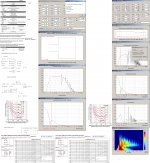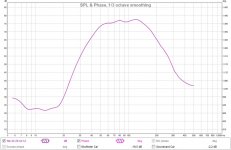The lowest notes played by an orchestra are notes from the Contra Octave reaching from C1 (32.7Hz) to B1 (61.7Hz). Orchestra instruments that reach the lower part of the Contra Octave are timpani and double bass (contra-bass). A large 81cm tympani has a D1 (36.7Hz) as lowest note. A standard contra-bass has its lowest note at E1 (41.2Hz). Sometimes they have a C1 (32.7Hz) as lowest key but it is rarely used.
The range from C0 (16.4Hz) to B0 (30.9Hz) is called the Sub Contra Octave. Instruments for that range are custom build and physically difficult to play. Of course, with the exception of church organs since they use air compressors these days. To play a sustain B0 note on a wind instrument you will need to have lungs of a hippo. After you have reached the athletic status because of all the carrying, the output level is not much more than a good fart. In case anyone wants to get rid of his smoking habits or consider a job as pearl diver, just buy a subcontrabass sax.
The Orchestra bass drum is the exception. It is the only instrument in the orchestra that isn’t a ‘clean pitch’ instrument. In contrary to the bass drum of many drumkits it is usually tuned in such way it has a rich low body with lots of overtones to avoid any audible tone. I guess the drumkit of Lars Ulrich will not be appreciated in classical circles but for him nothing else matters. Conductors usually ‘ask’ for a sound that is more felt than heard with an outstanding percussive attack. This is difficult to achieve and therefore these babies are often underappreciated. Most of them sound like a detuned drumkits or shoe boxes but when they do sound right they can have serious low end below 30 Hertz. It isn’t musical content but a wanted effect.
There are also electric instruments that can produce notes of the Sub Contra Octave. The 5 string bass for instance. It can be tuned down to A0 (27.5Hz) although not all 5 string will sound that good if used so low. To play the lowest frequency on a classic Hammond B3 you will have to use the left pedal. The output looks more or less like a cranked square wave of about 32.2Hz to 33.2Hz . To get it ‘stable’ for the C1 note (32.7Hz) is a profession on its own. Most Lesley’s don’t have the ability to support this frequency anyway.
I agree with Mr. Doom that below 27Hz there is nothing important for music in general. From a technical point of view ‘10Hz flatness’ in a ordinary home situation is nothing more than a hollow marketing phrase. That is besides the point that human hearing is not sensitive enough to hear level differences in a non-flat response at those frequencies you are talking. However, it doesn’t mean we cannot enjoy subwoofers that give an impression of the effects below 27Hz. If it is worth is just a matter of personal preferences and nobody will argue that.
The range from C0 (16.4Hz) to B0 (30.9Hz) is called the Sub Contra Octave. Instruments for that range are custom build and physically difficult to play. Of course, with the exception of church organs since they use air compressors these days. To play a sustain B0 note on a wind instrument you will need to have lungs of a hippo. After you have reached the athletic status because of all the carrying, the output level is not much more than a good fart. In case anyone wants to get rid of his smoking habits or consider a job as pearl diver, just buy a subcontrabass sax.
The Orchestra bass drum is the exception. It is the only instrument in the orchestra that isn’t a ‘clean pitch’ instrument. In contrary to the bass drum of many drumkits it is usually tuned in such way it has a rich low body with lots of overtones to avoid any audible tone. I guess the drumkit of Lars Ulrich will not be appreciated in classical circles but for him nothing else matters. Conductors usually ‘ask’ for a sound that is more felt than heard with an outstanding percussive attack. This is difficult to achieve and therefore these babies are often underappreciated. Most of them sound like a detuned drumkits or shoe boxes but when they do sound right they can have serious low end below 30 Hertz. It isn’t musical content but a wanted effect.
There are also electric instruments that can produce notes of the Sub Contra Octave. The 5 string bass for instance. It can be tuned down to A0 (27.5Hz) although not all 5 string will sound that good if used so low. To play the lowest frequency on a classic Hammond B3 you will have to use the left pedal. The output looks more or less like a cranked square wave of about 32.2Hz to 33.2Hz . To get it ‘stable’ for the C1 note (32.7Hz) is a profession on its own. Most Lesley’s don’t have the ability to support this frequency anyway.
I agree with Mr. Doom that below 27Hz there is nothing important for music in general. From a technical point of view ‘10Hz flatness’ in a ordinary home situation is nothing more than a hollow marketing phrase. That is besides the point that human hearing is not sensitive enough to hear level differences in a non-flat response at those frequencies you are talking. However, it doesn’t mean we cannot enjoy subwoofers that give an impression of the effects below 27Hz. If it is worth is just a matter of personal preferences and nobody will argue that.
Last edited:
Thank you for that information Djim
I know that electronic dance music can throw in whatever it feels like but I concentrate on real world classical music. 28Hz Hz sounds to be the lowest note in real music (except pipe organs) but in reality, if you make it that low, it will produce 99.999% of a typical music collection.
So when building subs for music, make sure the 28Hz and up is smooth and flat and sacrifice anything below that to obtain that flatness. Great info to know, it allows more flexibility in design.
I know that electronic dance music can throw in whatever it feels like but I concentrate on real world classical music. 28Hz Hz sounds to be the lowest note in real music (except pipe organs) but in reality, if you make it that low, it will produce 99.999% of a typical music collection.
So when building subs for music, make sure the 28Hz and up is smooth and flat and sacrifice anything below that to obtain that flatness. Great info to know, it allows more flexibility in design.
Hi,
Invented by reverse engineering a 18" fictive PA driver (calculated for similar performance) that IMO would be comparable with the driver in the Behringer box.
Result: Targeting 10 Hz is not a good idea but 20 Hz is possible if a loss of 24 dB is tolerable from the 127....I would choose the T-TQWT.
b
Invented by reverse engineering a 18" fictive PA driver (calculated for similar performance) that IMO would be comparable with the driver in the Behringer box.
Result: Targeting 10 Hz is not a good idea but 20 Hz is possible if a loss of 24 dB is tolerable from the 127....I would choose the T-TQWT.
b
Attachments
Hello,
as I state in one of my early post, I already got the 10Hz flatness, while actully I am just looking on how to optimize the result.
Here below the frequency response of the Sub + Woofer response of my system at the listening point (sorry to not be able to provide you a complete response up to 25 kHz... I am on vacation and in my notebook I have only this)
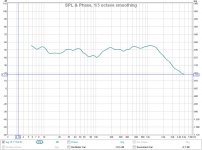
Actually, my focus is on optimize the linearity of this response and on the optimization of the Sub equalization that, due to the Behringer's limitations I explained in my post, is very heavy and surely is not the best from the acoustic quality point of "view".
Regards,
Andrea
as I state in one of my early post, I already got the 10Hz flatness, while actully I am just looking on how to optimize the result.
Here below the frequency response of the Sub + Woofer response of my system at the listening point (sorry to not be able to provide you a complete response up to 25 kHz... I am on vacation and in my notebook I have only this)

Actually, my focus is on optimize the linearity of this response and on the optimization of the Sub equalization that, due to the Behringer's limitations I explained in my post, is very heavy and surely is not the best from the acoustic quality point of "view".
Regards,
Andrea
Hi,
Flat to 10Hz is not the point. I can build a mini-monitor flat to 10Hz
but its completely inaudible, and fed wide range pink noise the low
bass will use up the drivers excursion limit, lowering overall levels.
Vented boxes are best tuned for the wanted audible bass limit at
audible levels and any bass below that filtered out. The real practical
limit is about 16Hz with an utterly monster subwoofer system.
For a real box with an 18" designed for PA detune the port and
add bass boost consistent with your domestic listening levels,
and your room response, which is critical to the lowest bass.
For a PA sub used domestically it makes sense, you don't need
PA SPL's and you can lower max SPL by 12dB increasing bass
extension by about an octave, with detuning and boost.
Boost is best done by a peaking 2nd order high pass filter.
Fundamentally bass extension without the also required SPL
is pointless, and limiting extension to improve maximum SPL
further up has to be done to get the best bass from a system.
rgds, sreten.
Flat to 10Hz is not the point. I can build a mini-monitor flat to 10Hz
but its completely inaudible, and fed wide range pink noise the low
bass will use up the drivers excursion limit, lowering overall levels.
Vented boxes are best tuned for the wanted audible bass limit at
audible levels and any bass below that filtered out. The real practical
limit is about 16Hz with an utterly monster subwoofer system.
For a real box with an 18" designed for PA detune the port and
add bass boost consistent with your domestic listening levels,
and your room response, which is critical to the lowest bass.
For a PA sub used domestically it makes sense, you don't need
PA SPL's and you can lower max SPL by 12dB increasing bass
extension by about an octave, with detuning and boost.
Boost is best done by a peaking 2nd order high pass filter.
Fundamentally bass extension without the also required SPL
is pointless, and limiting extension to improve maximum SPL
further up has to be done to get the best bass from a system.
rgds, sreten.
Hello Friends,
I verified yesterday that the Behringer B1800D-PRO has a protection HPF set around 30Hz with a 12 dB/oct roll-off.
I also opened the integrated class-D ampli and I definitively realized that without the electric and components placement schemas I shall need over 1 week of full time work to reverse engineer the input stage (supposing I can read out all the components code and so on).
So, I am now considering to give-up the modification of the ampli to remove the input HPF and to workaround it by heave counter-EQ.
Because the majority of you suggested to modify also the loudspeaker tuning, I got the enclosure volume and other details, so that you can give me suggestions.
The enclosure external measures are: 53 x 70 x 50 cm (L H D).
The internal net volume is about 125.3 litres (the ampli housing is about 23.5 litres in size)
The bass reflex tubes are 2 and are 25 cm long and 14.5 cm in diameter.
Internally, no foam on the walls but only a folded single foam sheet "V folded" around the loudspeaker.
The loudspeaker is a 18" PA woofer (no specs available, except the Behringer datasheet).
Because I am not familiar with T/S paramenters measurements, I didn't do any own measures, but having the right direction, I should do (supposing to have the needed tools).
Thanks in advance for your help!
Kind regards, Andrea
I verified yesterday that the Behringer B1800D-PRO has a protection HPF set around 30Hz with a 12 dB/oct roll-off.
I also opened the integrated class-D ampli and I definitively realized that without the electric and components placement schemas I shall need over 1 week of full time work to reverse engineer the input stage (supposing I can read out all the components code and so on).
So, I am now considering to give-up the modification of the ampli to remove the input HPF and to workaround it by heave counter-EQ.
Because the majority of you suggested to modify also the loudspeaker tuning, I got the enclosure volume and other details, so that you can give me suggestions.
The enclosure external measures are: 53 x 70 x 50 cm (L H D).
The internal net volume is about 125.3 litres (the ampli housing is about 23.5 litres in size)
The bass reflex tubes are 2 and are 25 cm long and 14.5 cm in diameter.
Internally, no foam on the walls but only a folded single foam sheet "V folded" around the loudspeaker.
The loudspeaker is a 18" PA woofer (no specs available, except the Behringer datasheet).
Because I am not familiar with T/S paramenters measurements, I didn't do any own measures, but having the right direction, I should do (supposing to have the needed tools).
Thanks in advance for your help!
Kind regards, Andrea
Behringer B1800D-PRO current setting performance
Hello Friends,
to let you better understand my current audio system "problems", and so better help me fix those, herein are some graphs you may "enjoy".
My sub frequency response at my LP (about 3m away).
Behringer B1800D-PRO setting as follows:
LPH cut: 70Hz
Boost: Enabled at 40 Hz
Volume: default 0 dB level
(No further DSP correction applied)
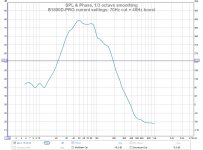
My audio system overall performace.
Thuneau 3way XOver with filters optimization
Strong (hard) 20Hz EQ correction applied (about +40dB) to the sub response in order to flattern its response.
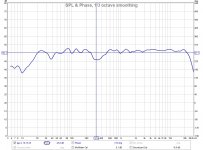
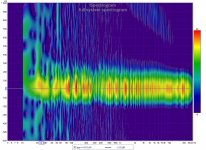
As you can see, the overall system performance is quite good, except below 30Hz that I don't like at all.
For the small issue around 340Hz I am working on the XOver filters.
For the "big" problems below 80Hz I need your help.
Many thanks in advance for anyone suggestions and help!
Kind regards, Andrea
Hello Friends,
to let you better understand my current audio system "problems", and so better help me fix those, herein are some graphs you may "enjoy".
My sub frequency response at my LP (about 3m away).
Behringer B1800D-PRO setting as follows:
LPH cut: 70Hz
Boost: Enabled at 40 Hz
Volume: default 0 dB level
(No further DSP correction applied)

My audio system overall performace.
Thuneau 3way XOver with filters optimization
Strong (hard) 20Hz EQ correction applied (about +40dB) to the sub response in order to flattern its response.


As you can see, the overall system performance is quite good, except below 30Hz that I don't like at all.
For the small issue around 340Hz I am working on the XOver filters.
For the "big" problems below 80Hz I need your help.
Many thanks in advance for anyone suggestions and help!
Kind regards, Andrea
Hi AndreaT,
Post #26: "...I am not familiar with T/S paramenters measurements, I didn't do any own measures, but having the right direction, I should do..."
This should get you there: Measuring Loudspeaker Driver Parameters
Without the correct T/S parameters you are just stabbing around in the dark.
Regards,
Post #26: "...I am not familiar with T/S paramenters measurements, I didn't do any own measures, but having the right direction, I should do..."
This should get you there: Measuring Loudspeaker Driver Parameters
Without the correct T/S parameters you are just stabbing around in the dark.
Regards,
Hi Djim,
I have to tell you that I was born and lived in Cavriago for 31 years, about 1 km away from 18Sound, but I never step-in their building!
In the case of RCF, instead, I visited them about 20 years ago and I contacted them recently when I was planning to do myaself my "new" subwoofer.
Then I decided to buy the Behringer B1800D-PRO because very cheap and immediately available.
Cosider that I paid € 430 for the B1800D-PRO, delivery included, while the only one 18" RCF subwoofer was priced around € 250, then I had to add an amplifier and the enclosure manufacturing, and also to take care of the overall design.
Anyway, I know the qualify of RCF and it is absolutely another planet compared to the very cheap and "Chinese styled" Behringer low-quality.
But for my in-home application, from 35Hz down, I considered it enough.
Cheers,
Andrea
I have to tell you that I was born and lived in Cavriago for 31 years, about 1 km away from 18Sound, but I never step-in their building!
In the case of RCF, instead, I visited them about 20 years ago and I contacted them recently when I was planning to do myaself my "new" subwoofer.
Then I decided to buy the Behringer B1800D-PRO because very cheap and immediately available.
Cosider that I paid € 430 for the B1800D-PRO, delivery included, while the only one 18" RCF subwoofer was priced around € 250, then I had to add an amplifier and the enclosure manufacturing, and also to take care of the overall design.
Anyway, I know the qualify of RCF and it is absolutely another planet compared to the very cheap and "Chinese styled" Behringer low-quality.
But for my in-home application, from 35Hz down, I considered it enough.
Cheers,
Andrea
Hello Tb46,
I read the "Measuring Loudspeaker Driver Parameters" instruction and I realized I have to take off the loudspeaker from the enclosure and the VAS calculation is a drag.
Any way to do some useful measurement keeping all moutend and just accessing the loudspeaker wires?
Many thanks and kind regards,
Andrea
I read the "Measuring Loudspeaker Driver Parameters" instruction and I realized I have to take off the loudspeaker from the enclosure and the VAS calculation is a drag.
Any way to do some useful measurement keeping all moutend and just accessing the loudspeaker wires?
Many thanks and kind regards,
Andrea
Hi AndreaT,
Post #32: "... useful measurement keeping all moutend and just accessing the loudspeaker wires?"
Measure the impedance curve of the driver in the box, this should tell you something about the driver/box combination. Then you may want to enter data into Hornresp. Use bjorno's simulation in Post #23 as a starting point, you can duplicate his BR (bass reflex/vented enclosure) input screen, change the enclosure data to reflect the volume, etc. of the Behringer, and see if you get close to your measured impedance curve.
It would be much better to remove the driver, and get the actual T/S data.
Regards,
Post #32: "... useful measurement keeping all moutend and just accessing the loudspeaker wires?"
Measure the impedance curve of the driver in the box, this should tell you something about the driver/box combination. Then you may want to enter data into Hornresp. Use bjorno's simulation in Post #23 as a starting point, you can duplicate his BR (bass reflex/vented enclosure) input screen, change the enclosure data to reflect the volume, etc. of the Behringer, and see if you get close to your measured impedance curve.
It would be much better to remove the driver, and get the actual T/S data.
Regards,
Hi Randomlf, the own response of my B1800D-PRO (no romm eq) is shown in the first graph of my post #27).
That graph refers to the specified settings (70Hz cut + 40Hz Boost), anyway, even the 120Hz cut + NO Boost is very similar, just shift right 50Hz the slope and reduce 5..7dB the 20Hz level.
This unit has an embedded class-D ampli that you cannot bypass, so some own eq is anyway present.
I also evaluated the VP1800, it is quite similar, except that is passive and that is an older design.
Then I selected the B1800D-PRO because of the active design (otherwise I had to buy another ampli too) and of its recent design.
Regards, Andrea
That graph refers to the specified settings (70Hz cut + 40Hz Boost), anyway, even the 120Hz cut + NO Boost is very similar, just shift right 50Hz the slope and reduce 5..7dB the 20Hz level.
This unit has an embedded class-D ampli that you cannot bypass, so some own eq is anyway present.
I also evaluated the VP1800, it is quite similar, except that is passive and that is an older design.
Then I selected the B1800D-PRO because of the active design (otherwise I had to buy another ampli too) and of its recent design.
Regards, Andrea
Hi, AndreaT
would it be possible to get photo of the driver rear / side?
wondering what kind of stuff Behringer is using for this one, might it even
be exactly the same as the most popular 18" driver Thomann is selling.
looking at the graph: -10 db@40Hz suggests high sensitivity.. 97+db/1w/m
-low mass low excursion driver. it is likely this driver is not happy
producing fundamentals below 30hz, so what would be heard in infra-areas
are to be mostly harmonics=distortion, at any meaningful volume.
and what about the amplifier? sounds like a bargain if it produces 1kw any significant length of time, some measurements from that too would be very
interesting. -been thinking of modifications to this same sub..
would it be possible to get photo of the driver rear / side?
wondering what kind of stuff Behringer is using for this one, might it even
be exactly the same as the most popular 18" driver Thomann is selling.
looking at the graph: -10 db@40Hz suggests high sensitivity.. 97+db/1w/m
-low mass low excursion driver. it is likely this driver is not happy
producing fundamentals below 30hz, so what would be heard in infra-areas
are to be mostly harmonics=distortion, at any meaningful volume.
and what about the amplifier? sounds like a bargain if it produces 1kw any significant length of time, some measurements from that too would be very
interesting. -been thinking of modifications to this same sub..
I guess the drumkit of Lars Ulrich will not be appreciated in classical circles but for him nothing else matters.
I see what you did there.
- Status
- This old topic is closed. If you want to reopen this topic, contact a moderator using the "Report Post" button.
- Home
- Loudspeakers
- Subwoofers
- Behringer B1800D-PRO 10-30Hz low bass extension
